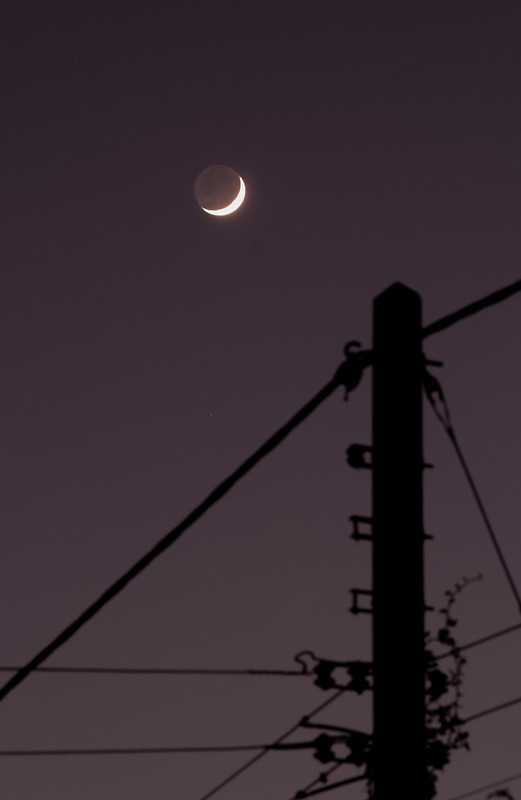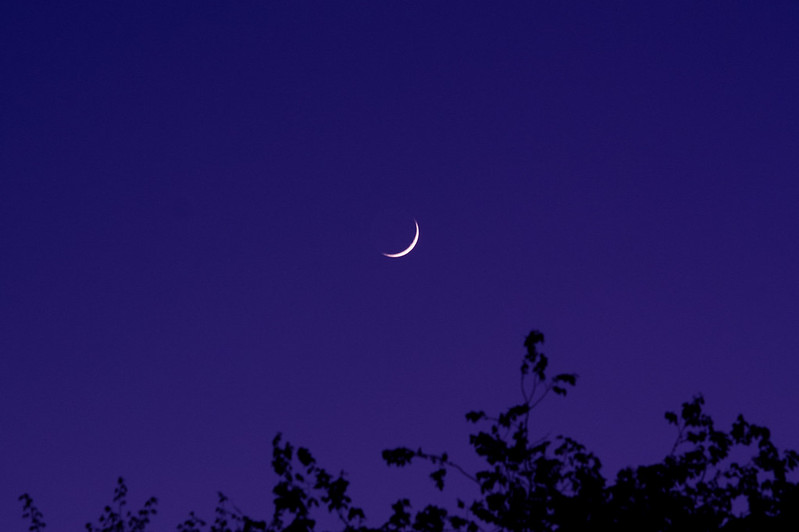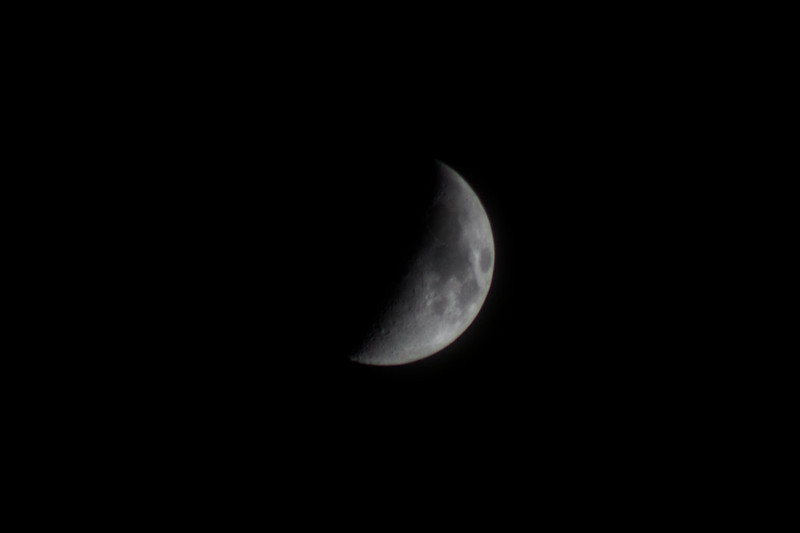Contents
It has been a strange couple of months, what with the current Coronavirus epidemic raging around us, but I have managed to capture a few astronomical events from the garden in any case. So here begins the April 2020 roundup.
ISS Passes
The International Space Station has made a number of bright passes in the evening skies for the last few weeks.
Tracking Exposure 26th March 2020

ISS passing through Taurus with the Pleiades (M45), taken 2020-03-26
This is a 90 second exposure at f/3.5 with an astro-modified EOS 450D and a EF50mm f1.8 II lens, at ISO 800 with a polar aligned mount tracking at Sidereal rate. In the top right corner of the frame is the Pleiades open star cluster (M45), also known as the Seven Sisters. The path of the ISS itself goes just to the left of the red giant α Tauri, Aldebaran which is the brightest star in the constellation Taurus. The stars scattered in and around Aldebaran are known as the Hyades, one of our closest open clusters, at approximately 153 ly distant.
Static Exposure 1st April 2020

ISS pass with clouds and trees, taken 2020-04-01
Low ISS pass taken 2020-04-01 at 20:36:38 UT on a (static) tracking mount. It is an 82 second exposure at f/3.5 with an astro-modified Canon EOS 450D and an EF50mm f1.8 II lens, at ISO 400. As can be seen the stars have trailed due the static mount, however a constellation can still be seen; Orion appears in the right hand half of the frame, complete with the very bright Orion Nebula (M42) making a fuzzy patch just above the electricity cables.
The Moon
With quite a few clear evenings in March and April this year, the Moon has been a very prominent target.
Earthlight 27th March 2020
In March this year I purchased a well loved Samyang 135mm T2.2 lens which gives me a 9°24.00' by 6°16.50' view of the sky with the Canon EOS 450D. I decided that some Moon shots would be a great way of giving it some first light.

Earthlight Moon taken on 2020-03-27 at 18:18:10 UT
I quickly set up in the garden for the above picture of the Moon with the express hope of capturing some earthlight. Picture taken with the Canon EOS 450D on a tripod; a 4 second exposure at ISO 400. Cropped and played about with a bit in Affinity Photo.
Pink Moon 8th April 2020
The full Moon in April was known as the "Pink Moon" and was also a "supermoon" due to its ever so slightly larger appearance; a result of the Moon reaching perigee in its orbit of Earth.

Pink Moon Rising with Moody Clouds on 2020-04-08 at 20:23:46 UT
The picture above was taken with the Canon EOS 450D and the Samyang 135mm T2.2 lens; a 1/6 second exposure at ISO 1600. Moon phase is 99%, Moon age is 15.7 days.
Young Moon 25th April 2020
Nipped outside to take a chance picture of a rather young Moon on the evening of the 25th April.

Moon, taken 2020-04-25 at 19:57:46 UT
Taken using the Canon EOS 450D and the EF 50mm f/1.8 II lens, 1/15 sec exposure at ISO 800. Moon phase is 3%, Moon age is 1.61 days. Cropped and played about with a bit in Affinity Photo.
Waxing Moon 29th April 2020
As luck would have it I inherited an old Canon EOS 550D with a Sigma 70-300 mm lens. Below is a first light attempt with the Moon.

Moon, taken 2020-04-29 at 21:02:51 UT
Above we can see the Moon waxing towards half with a 1/125 second exposure at ISO 800. Moon phase is 39%, Moon age is 6.3 days. Cropped and played about with a bit in Affinity Photo.
Lyrid Meteor Shower
This year I decided to have an attempt at getting a picture or two from the annual Lyrid meteor shower; capturing a meteor is something I have never tried before. The obvious solution seemed to be to aim a camera at or around the radiant area in the sky around the constellation of Lyra.
The Lyrids are visible from around 16th April to the 26th April, peaking typically on the night of the 22nd April.
In order to have the best chance of getting a meteor I figured that seeing as much of the sky as possible would be sensible. So it was time to bring out the F3.5/8 mm UMC Fish Eye lens and have a few hours under the stars. I decided to put the camera (Canon 450D astro-modified) onto the Skywatcher Star Adventurer mount in order to track at Sidereal rate. Some test pictures were taken initially, mainly to test various exposures, times and angles on the sky.
For all three nights the camera was controlled using a laptop running a piece of software called Astrophotography Tool.
Night 1 - 20th April 2020
I set the camera running at 23:05 UT with a planned sequence of 100 exposures, 120 seconds each at ISO 800. Unfortunately I had accidentally set the aperture to F/22 whilst setting up in the dark. Not much was captured this night as a result.
Night 2 - 21st April 2020
This night, I made sure that the lens aperture was set correctly at F/3.5!
Below is a single exposure, taken from a series of test exposures, 120 seconds at ISO 800. Stacked using Deep Sky Stacker, finished off using Affinity Photo in black and white.

Lyrid Meteor bursts in Leo, taken 2020-04-21 at 21:21:06 UT
The wide angle lens takes in the long track of the meteor rather well; the track stretches from the constellation of Boötes, right across Coma Berenices and into Leo where it finishes in a flash.
Happy with the tests, I set up for a series of exposures aimed at capturing the post midnight peak - starting at 23:04 UT and running until 03:20 UT. The sequence consisted of 102 files, 150 seconds each at ISO 800 when complete. Not a single frame had captured a meteor.
Night 3 - 22nd April 2020
My luck was in; a third clear night in a row! Once again the camera was set up with the fish eye lens, however this time I started a little earlier due to some incoming cloud later on in the night. This nights' sequence planned in a series of 101 exposures, 152 seconds each at ISO 800 from 21:26 UT to 01:41 UT the following morning.
This night proved to be moderately more successful with two meteors captured. neither were awe-inspiring, but I was happy with having at least something at the end of the session.

Meteor in Coma Berenices during the Lyrids shower, taken 2020-04-22 at 22:07:19 UT
So you have to look quite hard to see this first one (picured above), just to the right of centre of the frame, making its way through the constellation of Coma Berenices.

Lyrid meteor in Ursa Major and Minor 2020-04-23 at 00:22:33 UT
The second capture took place the other side of midnight, streaking a 26° long line between the stars of Alkaid (η UMa) and Kochab (β UMi). The image above has been cropped quite significantly and changed to black and white from a colour exposure using Affinity Photo.
That was it for the Lyrids this year; quiet and nowhere near as exciting as it could have been, but it does seem that most meteor hunters had a similar experience. Roll on the next meteor shower.
Star Trails
Having recently got hold of a fish eye lens I thought that it would be interesting to leave the camera pointing at the sky, take a series of reasonably long exposures and stack them together to generate some star trails. Being that the stars move approximately 15° per hour, it made sense that even a short amount of exposure time would produce some reasonable star trails.

Back Garden Star Trails 2020-04-16
This first image comprises 30 exposures of 60 seconds each, at ISO 400, using the Canon EOS 405D with the F3.5/8 mm UMC Fish Eye lens.

Looking for Lyrids 2020-04-20
This second image is a composite from a sequence of 102 exposures at 150 seconds each, ISO 800 from one of my attempts to capture meteors during the Lyrid meteor shower. Again these were taken with the Canon EOS 405D and F3.5/8 mm UMC Fish Eye lens No meteors imaged, but a good set of star trails nevertheless.